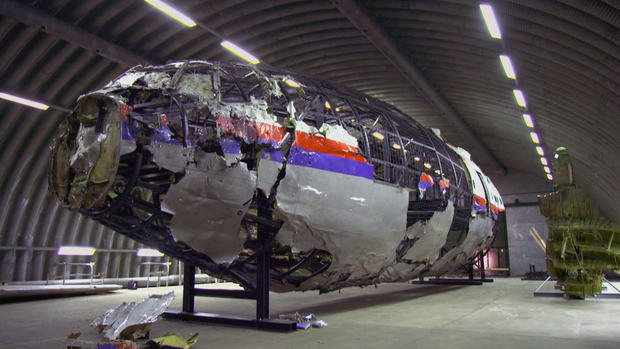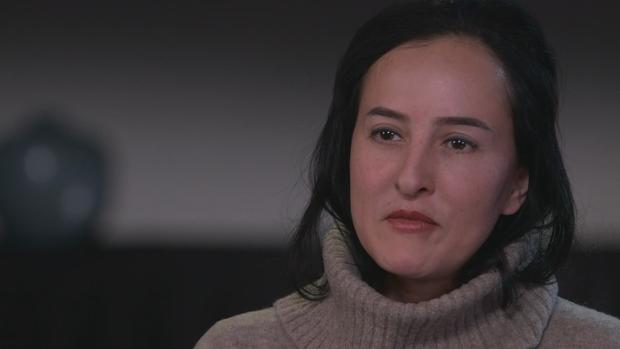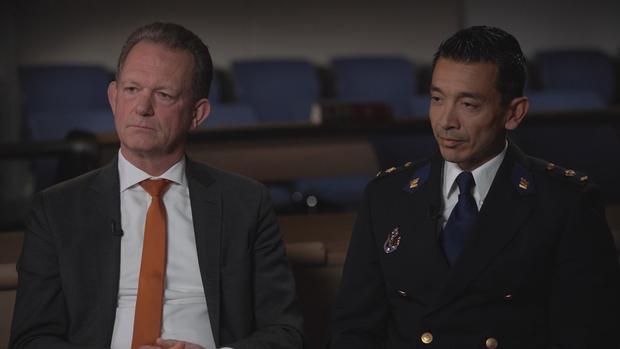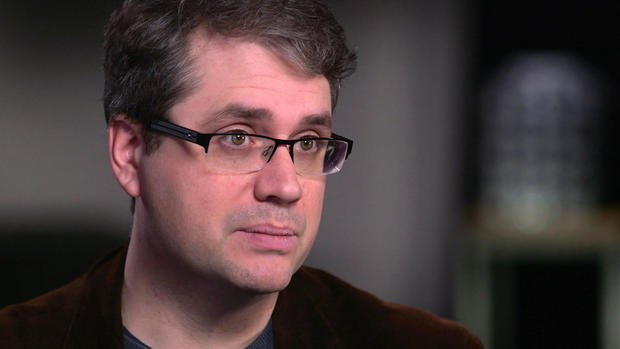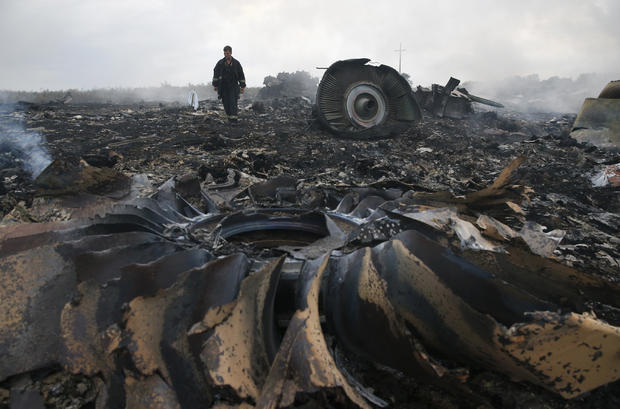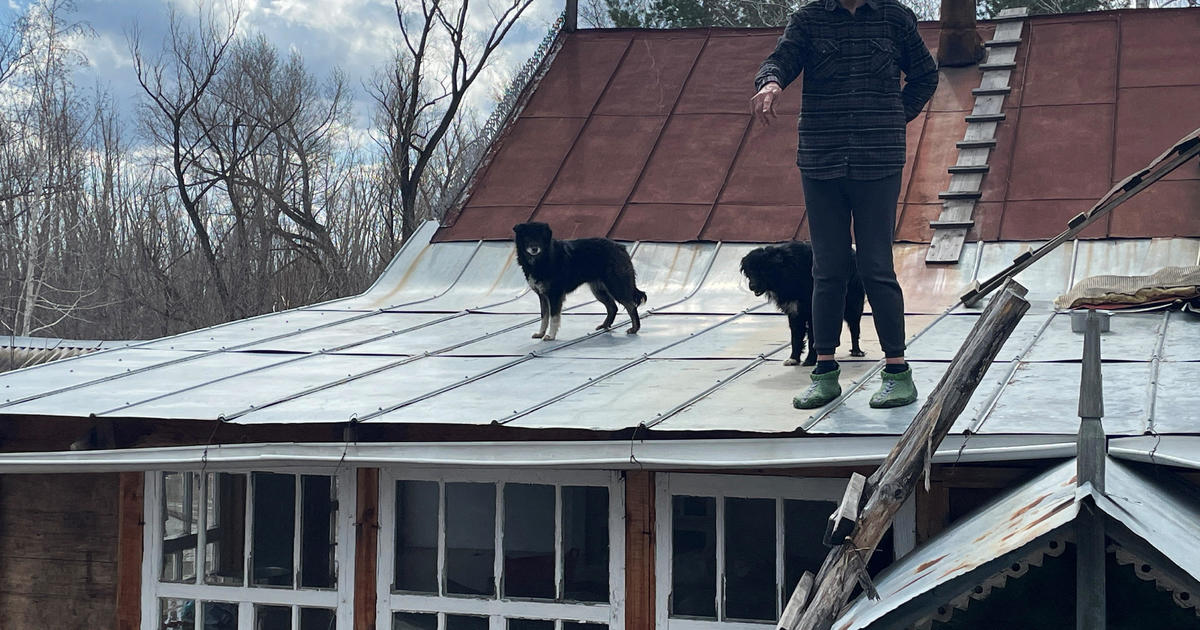The long pursuit of justice for victims of MH17, the passenger jet shot down over Ukraine
With a single shot, 298 men, women and children were massacred in Ukraine. The dead were traveling from Amsterdam to Malaysia when an anti-aircraft missile shredded their widebody airliner. That was six years ago and no one has been held accountable. The downing of Malaysia Flight 17 was a shock to the world. How could innocent civilians leaving the Netherlands on vacation to Asia lose their lives in a war Russia started with Ukraine? As we first reported in February, after a years-long investigation, Dutch prosecutors say they know who is responsible. This is the story of the hunt for the suspects charged with 298 counts of murder.
- How Bellingcat tracked a Russian missile system in Ukraine
- 60 Minutes producer Henry Schuster explains the evolution of the story on MH17
- Reconstruction of MH17 reveals final moments of doomed flight
In a Dutch hangar, heavy with the smell of fuel and fire, Malaysia Flight 17 has been resurrected from 8,000 fragments. The Boeing 777, 20 feet wide and 200 feet long, was torn by an estimated 800 pieces of shrapnel, each the size of a bullet. A warhead detonated ten feet to the left of Captain Eugene Choo's windscreen. The Dutch Safety Board says the greatest density of holes, 102, is through the pilot's window. Shrapnel tore through the cockpit and out the other side. The cockpit sheared away. And the rest of the plane flew another minute and a half. Passengers were thrashed by explosive decompression and a 500 mile an hour wind at 40 degrees below zero. One passenger was found wearing his oxygen mask.
"I want to know who killed my children," Samira Calehr said.
It was July 17, 2014, that Calehr walked her boys, 19-year-old Shaka and 11-year-old Miguel, as far as Amsterdam airport security would let her. The youngest boy was worried.
"He hugged me really tight," Calehr told 60 Minutes correspondent Scott Pelley. "And he told me like, 'Mom, I'm so afraid to take this plane. You know, I'm so afraid what happen when the airplane will crash?' I told him, 'Miguel, come on, you've been on flights many times. You are with Shaka. Everything is going just to be fine.' He said, 'You promise me?' I said, 'I promise everything will be okay.'"
The brothers were going to see their grandmother in Bali. Calehr planned to come back to the airport the very next day because her middle son, Mika, couldn't get a seat on flight 17.
"So, I never got a proper goodbye, said a proper goodbye, and that really is something that I have to deal with for the rest of my life," Mika said.
"I cannot forgive myself that I promised my baby, Miguel, that everything will be fine," Samira Calehr said. "Who am I to tell him that everything's going to be okay?"
"That's what a son wants to hear from his mother," Pelley said to her.
"But I feel like I lied to him," Calehr said. "Who am I to give him that guarantee? It's been like hell. I feel emptiness. I feel sadness. There is a hole in my heart. It will always hurt. And I miss them every day."
Her boys were among 193 Dutch citizens onboard.
Shrines in Dutch homes are common including the one to Piet Ploeg's brother, sister-in-law and nephew, all on board the airliner that day. His nieces didn't go on their family vacation.
"It's 9/11 for the Netherlands," Ploeg said. "The Netherlands, all people in the Netherlands were very, very, very shocked."
Ploeg had to tell his nieces what had happened.
"I don't want to think too much about that moment. It's too emotional for me," Ploeg said. "I saw my nieces falling in each other's arms when they realized their parents and their brother were dead. It was a terrible, terrible moment."
"No one had any understanding that they were going to be flying over a warzone," Pelley said to Ploeg.
"Oh, you didn't think about it and after MH17 we always think about it," Ploeg said.
Flight 17 was three hours into a 12-hour route when it came within range of a war. In 2014, Russia dismembered its neighbor to the west. It annexed Crimea, which was part of Ukraine and, today, pro-Russian militias, supplied and manned by Moscow, are fighting to control a portion of eastern Ukraine. In the days before the Flight 17 murders, two Ukrainian military planes were shot down. But despite that, the day Flight 17 entered the airspace, 160 airliners crossed over Ukraine. It was cloudy. Flight 17, at 33,000 feet, appeared only on radar until it fell through the clouds across 20 square miles.
"We considered it a national crisis. Because, if you think, it was not only that we were doing a criminal investigation but the most important thing in the beginning was the recovery mission," Andy Kraag, the lead police investigator for the Netherlands, said. "First, we needed to recover all the casualties to get them back home, so that the next of kin could mourn. Actually, we were in national mourning."
In a nation so small it seemed everyone knew someone touched by the murders. For days, convoys of hearses, stretching beyond sight, were met by gauntlets of grief. Fred Westerbeke is the chief prosecutor who's been on the case from the start.
"We were able to identify, from the 298 casualties, 296. So, for two people we didn't find any remains," Westerbeke said.
With no admission of guilt, 350 investigators from five countries – the Netherlands, Australia, Ukraine, Belgium and Malaysia -- began almost six years of work. They were known as the Joint Investigative Team (JIT).
"We started with multiple scenarios in the beginning," Kraag said. "One was, was it an accident? That could be discarded quite quickly. The other one, was it an explosion from the inside? And the last two, most importantly, was it air-to-air, like, was it shot by a plane? Or was it surface to air?"
Those scenarios narrowed quickly because of a technique new to the police: civilian internet investigators. Just days before the murders, Eliot Higgins started a U.K.-based group of online detectives that he calls Bellingcat, named for a fable of mice tying a bell to a cat to warn of danger. Higgins found images, crowdsourced online.
"So this is one of the first videos that was shared online after MH17 was shot down. And it was shared claiming that this was a Buk missile launcher," Higgins said.
But how did Higgins know he was looking at the same convoy across all his images?
"So there's certain details that kind of leap out at us," Higgins said, pointing to an image on a computer monitor. "There's the white truck. But you can see there's a black exhaust pipe on the side of that truck. It's a very small detail. But it does help us show that it's very similar to the truck that's in other photographs and videos."
Matching randomly-sourced pictures with geolocation techniques, Higgins and his colleagues spotted an anti-aircraft system in the right place on the right day. Images that had been shot earlier led him to the convoy's starting point.
"And that took us back to a town called Kursk," Higgins said. "And in Kursk, there's a missile brigade called the 53rd Air Defense Brigade, and we were able to establish for certain the missile launcher came from that particular brigade."
"And Kursk is in Russia," Pelley said to Higgins. "And the 53rd Brigade is a Russian military unit."
"Yes," Higgins said. "And it was probably very likely crewed by Russian crew."
Higgins also discovered the missile system retreating after the shoot-down, with one, incriminating, difference: a missile was missing.
"So, there's one there. There's one there," Higgins said, pointing at another image. "And there's one just out of the back of there as well. But there should be a missile between these two missiles,"
It wasn't long before Eliot Higgins got a call from Dutch investigators.
"That was pretty groundbreaking at that time," Kraag said of the information the Joint Investigative Team received from Bellingcat. "So, we've learned a lot from them as well. But that's just one layer of the evidence, because we have to build up evidence that can stand in court. We also have the witnesses, forensic evidence etc."
The investigators told us that layers of evidence came from the weapon itself, known as a BUK Telar. Its missile warhead is packed with unique bowtie-shaped shrapnel. This signature shrapnel was found in the bodies of the flight crew. Another layer of evidence came in thousands of phone calls, intercepted by Ukrainian intelligence from among Russians and their allies.
"We have just shot down a plane," a rebel commander said before realizing the catastrophic mistake. Yet another layer of evidence was supplied by Ukrainian villagers.
"You have eyewitnesses to the missile launch," Pelley said to Westerbeke. "Is that correct?"
"Yeah," Westerbeke said.
"More than one?" Pelley asked.
"I'd say I have an eyewitness. And how many, I didn't say how many," Westerbeke said.
Westerbeke said there is no doubt the missile system came from the 53rd Brigade of the armed forces of the Russian Federation.
They don't know who pushed the button, but, this past summer, Dutch prosecutors charged three Russians and a Ukrainian with 298 counts of murder: Sergey Dubinsky was head of intelligence for the pro-Russia rebels in Ukraine, prosecutors say; Oleg Pulatov, and Leonid Kharchenko were involved in delivering the missile system. The highest-ranking Russian accused is Igor Girkin, a retired colonel in Russian intelligence. He was in charge of the pro-Russia militia in Ukraine. We found him in Moscow, living under the protection of the Russian government. He told us, "Someone has to be the scapegoat, so they picked me and others who couldn't even theoretically shoot down this plane. The militia did not bring down the Boeing plane. I have no other comment."
Westerbeke said the Russians haven't been helpful at all in the investigation over the last five years.
"Because what they should've done is give us all the information and all the proof we needed in this difficult investigation," Westerbeke said. "They should have told us that at the second day after it happened, they should've told us, 'We made a mistake,' or 'We did something which shouldn't have happened.' They should have come forward. That is what they should have done, and they never did."
Still unhelpful, the Russians will not extradite the defendants. Samira Calehr said it won't be enough for her if the defendants are convicted, but aren't in the courtroom. Her son, Mika, agreed.
"Everybody will be haunted by the fact that they're still out there and not in custody," Mika said.
The trial is scheduled to begin March 9 and will be heard by a panel of three Dutch judges. Samira Calehr told us she will not attend. Piet Ploeg will not miss it.
"I want them to know what they have done, and what they have done to not only to the victims but also the next of kin," Ploeg said. "They have to feel it."
Prosecutors told us their investigation is continuing beyond the trial. They hope to charge additional suspects. For its part, Russia has spun any number of stories about what might have killed 298 innocent victims. Stories that, so far, have not withstood the evidence presented by the silent witness of Malaysia Flight 17.
The trial began as planned in March and will likely run through the end of the year. Samira Calehr still has not attended.
Produced by Henry Schuster. Associate producers, Sarah Turcotte, Rachael Morehouse and Ian Flickinger. Edited by Patrick Lee.
